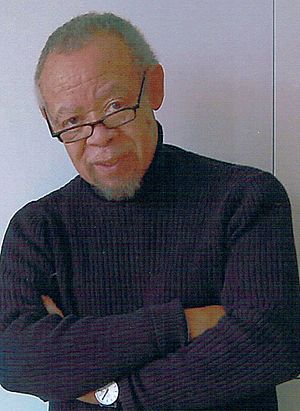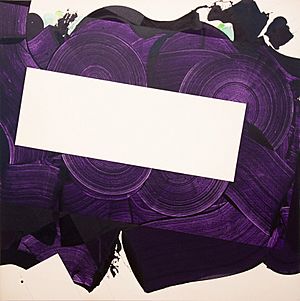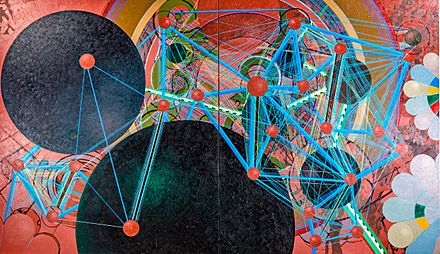Robert Reed (artist) facts for kids
Quick facts for kids
Robert James Reed
|
|
|---|---|
 |
|
| Born |
July 9, 1938
|
| Died | December 26, 2014 (aged 76) |
Robert James Reed Jr. (born July 9, 1938 – died December 26, 2014) was an American artist. He was born in Charlottesville, Virginia. Reed taught painting and printmaking at the Yale School of Art for 45 years. In 1987, he became a permanent professor at Yale. At the time of his death, he was the first and only African-American to hold such a position in the school's 145-year history.
Reed was known for his art style called geometric abstraction. He used shapes, colors, and textures to create his unique images. He explained that his art included pieces of memories, paths, and symbols from different cultures. He also used images from his childhood. His abstract art was based on real shapes found in the world. He created paintings, drawings, monotypes, prints, and collages.
Contents
Robert Reed's Early Life and School
Robert Reed was born in Charlottesville, Virginia, in 1938. He went to segregated public schools there. These included Jefferson elementary and Burley high schools.
He earned his bachelor's degree (B.A.) from Morgan State, a historically Black college in Maryland, in 1958. However, his graduation was officially recorded in 1959. This was because he had to pay off his final tuition first. He then earned his Bachelor of Fine Arts (B.F.A.) in 1960 and Master of Fine Arts (M.F.A.) in 1962 from the Yale School of Art.
While at Yale, Reed learned from famous artists like Josef Albers, Neil Welliver, and Jon Schueler. Later, he was also influenced by Philip Guston. Guston was a colleague at Skidmore College in the mid-1960s.
In 1960, Reed was chosen to attend the Yale Norfolk Summer School of Art. He said this summer program was very important for him as an artist. There, he met another student, Özer Kabas. When Reed returned to Yale, Kabas helped him get a job working for Josef Albers. Reed helped Albers prepare his first Interaction of Color book. Reed's job was to mix colors for the printing plates. He would mix silkscreen inks and write down the color recipes. Albers would check his work often.
Reed strongly believed in Albers' way of teaching art. He continued to use these ideas throughout his own teaching career.
Robert Reed's Career as an Artist and Teacher
Teaching Art at Colleges
Reed started his career as an art teacher in 1962. He was an assistant professor at the Minneapolis College of Art and Design. After that, he taught at Skidmore College in Saratoga Springs, New York, from 1965 to 1969.
In 1969, Reed began teaching at the Yale School of Art. He started as an assistant professor of painting. In 1987, he became a permanent professor of painting. He held this important position until he passed away in 2014.
From 1970 to 1975, Reed was the director of the Yale Summer School of Art. During his time as director, he brought many famous artists to teach. These included Philip Guston, Chuck Close, Al Held, and Romare Bearden. Reed would sometimes take his college students to Norfolk. There, he would give them a shorter version of the summer art experience over a weekend.
Reed also helped judge or organize many art shows. These included shows at the Creative Arts Workshop and Artspace in New Haven, Connecticut.
He was a guest artist and speaker at over 60 colleges and universities. He also spoke in Europe.
Reed created several art education programs. These included Acre in Spokane, Washington, and The Institute for Studio Studies in Auvillar, France.
He served on the boards of several art organizations. These included the Lyme Academy College of Fine Arts and the MacDowell Colony.
Robert Reed's Artistic Journey
Even while teaching, Reed was always creating art. He produced new groups of artworks every 8 to 10 years. His art career began in the 1960s. He had early success with a solo show at the Whitney Museum of American Art in 1973.
Reed was dedicated to abstract art. In the 1970s, he did not give in to pressure to create "Black identity art." He explained in an interview that he saw himself as an artist who happened to be Black. He used his experiences as a Black person to inspire his art in his own way. He knew what it was like to face unfair treatment. He found different ways to show these feelings in his abstract work.
However, Reed was often overlooked during the Black Arts movement of the 1960s and 1970s. He continued to work quietly. This was partly because he focused on developing his own unique art style. It was also partly due to the sad deaths of his mother and sister in 1965. This made him very private about his life and art.
Some of Reed's most famous art series are:
- Plum Nellie (1970s): In this series, he used colors to represent characters and landscapes. This was inspired by his work on the Interaction of Color book.
- San Romano (1980s): This series honored the 16th-century paintings of battles by Paulo Uccello.
- Tree For Mine (1990s): This was a personal look at the people and places from his childhood home in Charlottesville, Virginia.
- Galactic Journal (2000s): This was a very personal series that showed the paths of his life over almost eight decades.
Art Collections, Awards, and Shows
Robert Reed's artworks are kept in many museums. These include the Whitney Museum of American Art in New York City. His art is also at the National Academy Museum in New York. Other museums include the Hirshhorn Museum and Sculpture Garden in Washington, D.C., and the Minneapolis Institute of Art. His work is also in the Yale University Art Gallery and the Fralin Museum of Art.
In 2015, his work was part of a big exhibition called "America Is Hard To See." This show opened the new Whitney Museum of American Art building in New York.
Reed received many awards and honors, such as:
- Yale University, William Devane Medal for great undergraduate teaching, 2014.
- National Academy of Design fellow, New York, 2009.
- College Art Association Distinguished Teaching of Art Award, 2004.
- Honorary Doctorate of Fine Arts, Minneapolis College of Art and Design, 2001.
To honor Reed's teaching, the Robert Reed Scholarship Fund was created at the Yale School of Art. Also, a classroom at the Yale School of Art was named the "Robert Reed Studio." At the entrance, there is a quote from Reed to his students: "Drawing is a search, not a destination."
In 2015, a special art show called "Robert Reed: Non-Stop Painting" was held. It showed many of his works. This show was organized by Robert Storr, who used to be the dean of the Yale School of Art.
Robert Reed's Personal Life
Reed was a member of the Alpha Iota chapter of the Kappa Alpha Psi fraternity since 1956. He served as president of his group.
Robert Reed passed away from cancer in New Haven, Connecticut, on December 26, 2014. He is buried at the historic Grove Street Cemetery in New Haven.



